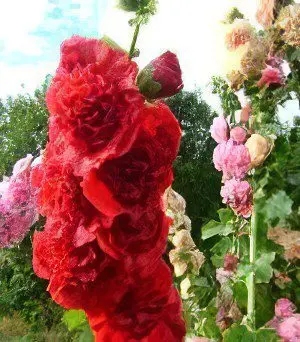Contents
Useful properties and use of stock roses, care and planting
Useful properties of stock roses

Stock Rose is a delightful tall plant, which is often used for spectacular decoration of arbors and fences. Such a plant has powerful stems with beautiful branching from the very base. Its height can reach 250 cm. On the shoots of the stock rose there are interesting large leaves with felt pubescence. Abundantly blooming stock-rose can be called an excellent honey plant. The birthplace of such an elegant plant is the Balkan Peninsula.
This beautiful flower is also widely used for medicinal purposes. It contains a huge amount of essential plant mucus. Mineral components, dye, tannins, phytosterol, bitterness and starch were found in the flowers. Harvest raw materials during flowering. As a rule, buds are collected together with a cup, and then they are thoroughly dried in the open air.
Stock rose is indicated in the treatment of cough and bronchitis. Various water decoctions and infusions of the plant are used as mucous, emollient, astringent and anti-inflammatory agents. They are often prescribed for gastric and intestinal ailments, as well as for the treatment of pathologies of the respiratory system. This plant can be taken in the form of herbal tea with honey. In addition, such a drink effectively relieves inflammation of the kidneys and unpleasant symptoms of diarrhea. It can also be used externally for gargling and mouthwash for inflammation or as a compress.
Stock-rose flowers
Stock-rose inflorescences are characterized by a rather long spicate shape. The flowers are represented by large funnel-shaped specimens. They can be of various shades – white, pink, purple, red and even yellow. As a rule, after flowering, a fruit is formed, which tends to break up into small parts. Large double flowers are located in the axils of the leaves and form apical brushes. The plant blooms from August to mid-autumn.
The use of stock roses
With a strong cough, you can use herbal tea from this plant, which softens and alleviates the course of the disease. To prepare such tea, you need to take 2 teaspoons of flowers and pour 250 ml of boiling water. Tea should be brewed for about 10 minutes. It is recommended to take such a remedy with a small amount of honey for hoarseness, cough, sore throat and asthma. Due to the enveloping and anti-inflammatory action, preparations containing such a plant are indicated for skin ulcers and extensive purulent wounds. In addition, the regular use of infusions from flowers produces a tonic effect.
In modern cosmetology, stock-rose helps to activate melanin in the skin, and also has moisturizing and softening properties. In addition, this plant is used to normalize fat balance. A decoction of flowers is prepared based on the proportion of 10 grams of raw materials per 100 ml of water. Take this remedy inside should be 1 tablespoon at least three times a day.
Stock rose care
Such an original plant as a stem-rose prefers loose and rich in organic soils. It also likes abundant watering, but does not tolerate excessive dampness. Since the stock rose has highly branched long roots, it does not tolerate various transplants very well. To plant such a plant, choose sunny and wind-protected places in the front garden. Don’t expect a stock rose to flower in the first year, it’s only capable of producing a large rosette of large leaves. In the second year of life, the plant will grow and will surely please with chic flowers.
Planting stock roses
Reproduction of such a beautiful plant is carried out with the help of seeds. It should be noted that some terry varieties are bred by cuttings. Rooting of shoots is recommended to be done in spring, and in the middle of summer, stem cuttings can be used. Seeds should be sown at a permanent place of growth at the end of April, 2-3 pieces in each hole, while the distance between the holes should be at least 50 cm. Planting depth is recommended about 3 cm. Sowing seeds for standard seedlings is carried out in March. As a rule, separate pots are chosen for this purpose, the diameter of which is at least 10 cm. To obtain seedlings in greenhouse conditions, the seeds are sown in May or June. If you need to dig up plants, be sure to save a clod of earth with roots. This condition guarantees a good survival rate of the stem-rose for the next year. Thanks to this, it will more easily go into intensive growth, which is very important for every gardener.
Contraindications to the use of rose stock
Side effects with the use of stock roses have not been identified.









